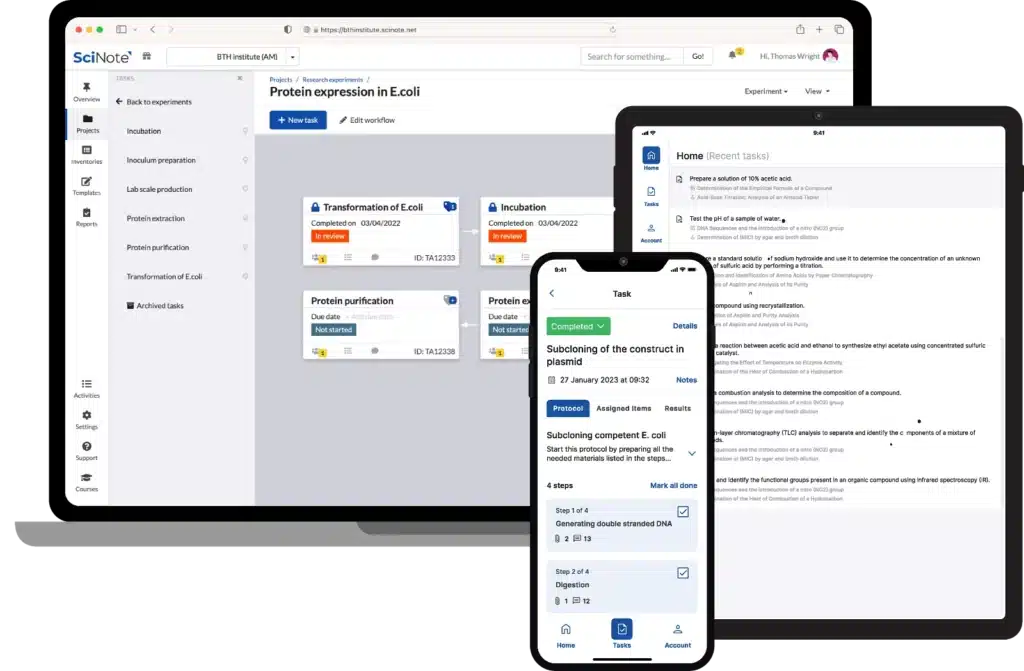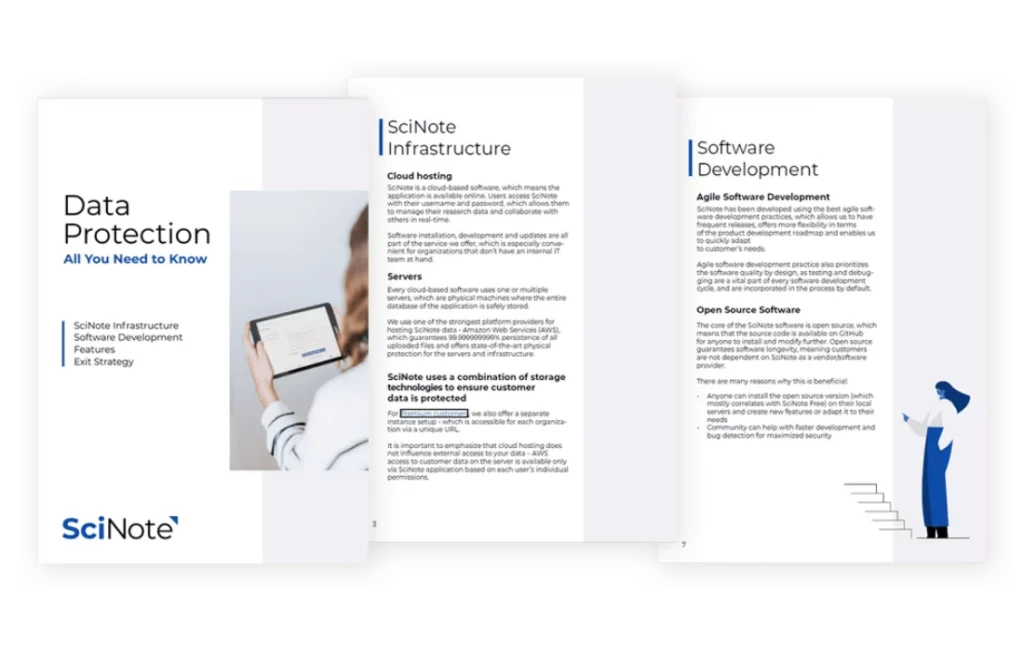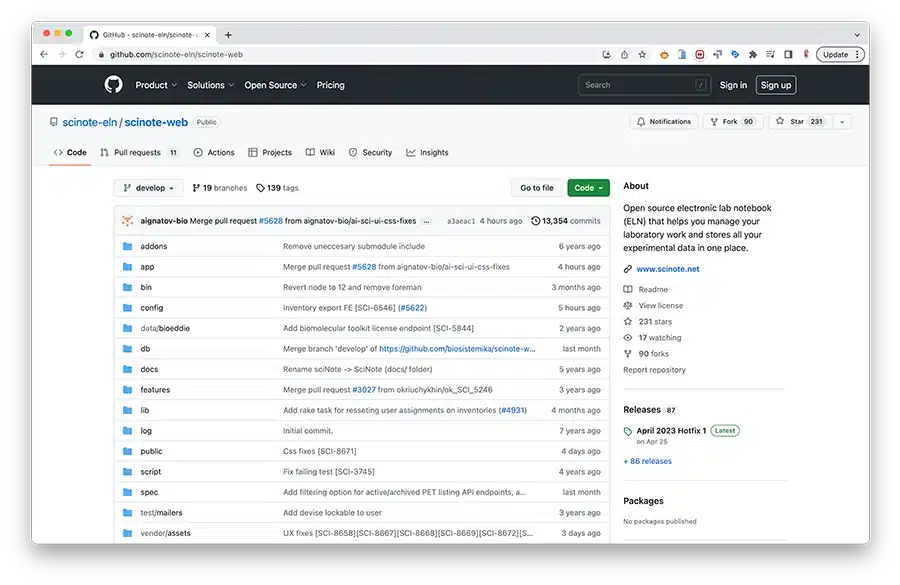
In the fast-paced world of scientific research, the ability to efficiently collect, manage, and share data is paramount. Traditional paper lab notebooks, while once the standard can no longer keep up with the demands of modern research. Enter the Cloud-Based Electronic Lab Notebook (ELN), a digital tool that’s revolutionizing how scientists record and collaborate on their work. In this article, we’ll explore the many ways in which cloud-based ELNs are transforming the research landscape, enhancing efficiency, and making life easier for scientists.
The Basics of Cloud-Based Electronic Lab Notebooks
Cloud-based Electronic Lab Notebooks (ELNs) have revolutionized the way scientific research is conducted. They offer a flexible and efficient way to document, manage, and share research data. In this section, we’ll delve into the fundamental aspects of cloud-based ELNs, including what they are, their features and capabilities, a comparison with traditional paper lab notebooks and desktop-based ELNs, and the significance of cloud technology in scientific research.
Explanation of what cloud-based ELNs are
Cloud-based ELNs are digital platforms that enable scientists and researchers to record, organize, and collaborate on their experiments and research data in a secure online environment. Digital notebooks such as the SciNote ELN are hosted on cloud servers, making them accessible from anywhere with an internet connection. They provide a user-friendly interface for data entry and retrieval, often resembling the format of a traditional lab notebook.
Key points:
- Cloud-based ELNs are digital repositories for research data.
- They are accessible through web browsers, eliminating the need for physical lab notebooks.
- Cloud hosting ensures data availability from various devices, enhancing flexibility.
Features and capabilities of cloud-based ELNs
- Real-time Collaboration: Cloud-based ELNs allow multiple researchers to work on the same project simultaneously, fostering collaboration. This feature is invaluable for research teams spread across different locations.
- Data Security: They offer robust data security, including encryption and access control, to protect sensitive research information.
- Version Control: Cloud ELNs automatically track changes made to entries, enabling users to review and revert to previous versions when necessary.
- Data Search and Retrieval: Advanced search functionalities make it easy to locate specific data points or experiments within the notebook quickly.
- Integration with Lab Equipment: Many cloud ELNs can connect to laboratory instruments, enabling automated data capture and reducing manual data entry errors.
Comparison with traditional paper lab notebooks and desktop-based ELNs
Traditional Paper Lab Notebooks:
- Tangible Format: Paper notebooks are physical and can be vulnerable to damage, loss, or theft.
- Limited Accessibility: They are confined to the physical location, making it challenging for remote collaboration.
- No Data Analysis Tools: Paper notebooks lack built-in data analysis tools and may require manual data transcription.

Desktop-Based ELNs:
- Local Hosting: These ELNs are installed on specific computers, limiting access to a single location or network.
- Maintenance and Backups: Users are responsible for system maintenance and data backups.
- Offline Access: Desktop ELNs may not be as accessible when offline.
Cloud-Based ELNs:
- Accessibility: They offer universal access from any device with an internet connection.
- Data Security: Data is stored securely in the cloud with automated backups.
- Real-time Collaboration: Facilitates efficient teamwork and collaboration on research projects.
The Significance of Cloud Technology in Scientific Research
The adoption of cloud technology has brought transformative changes to scientific research. It offers researchers a scalable and cost-effective way to manage data, share insights, and accelerate scientific discovery. Cloud-based ELNs, in particular, play a crucial role in:
- Data Preservation: Cloud-based ELNs ensure data preservation and accessibility, reducing the risk of data loss due to physical damage or unforeseen circumstances.
- Global Collaboration: Scientists and researchers from different parts of the world can seamlessly collaborate in real time, fostering innovation and knowledge exchange.
- Data Analysis and Insights: Cloud ELNs often come with built-in data analysis and visualization tools, allowing researchers to draw insights from their data more efficiently.
- Compliance and Security: Cloud-based ELNs often adhere to strict data security standards, aiding research institutions in compliance with regulatory requirements.
Advantages of Using Cloud-Based ELNs
Cloud-Based Electronic Lab Notebooks (ELNs) offer a wide array of advantages that significantly enhance research processes and data management. In this section, we will explore these advantages, including data accessibility and collaboration, data security and backup, and version control with audit trails.
Data Accessibility and Collaboration
- Real-time Access from Anywhere: Cloud-based ELNs allow researchers to access their data from anywhere with an internet connection. This means that whether you’re in the lab, at home, or traveling for a conference, your research data is just a click away.
- Collaboration Among Team Members: Cloud-based ELNs promote seamless collaboration. Researchers can work together on projects in real time, regardless of their physical locations. This capability is particularly beneficial for research teams distributed across different time zones, allowing them to work together as if they were in the same room. The power of open source electronic lab notebook is harnessed here, as they encourage collaborative contributions from the community.
Data Security and Backup
- Secure Data Storage: Cloud-based ELNs ensure data security through robust encryption and access control mechanisms. Storing your data in the cloud provides an added layer of protection against data loss, theft, or unauthorized access. This is especially crucial for sensitive research data.
- Automated Backups and Data Recovery: The cloud-based infrastructure automatically backs up your data, reducing the risk of data loss due to hardware failures or other unforeseen events. In the event of data corruption or loss, recovery is simplified with cloud-based ELNs. You can retrieve previous versions of your work, reducing the potential impact of accidental deletions or data corruption.
Version Control and Audit Trails
- Tracking Changes and Edits: Cloud-based ELNs maintain detailed records of all changes made to entries. This feature allows researchers to track who made specific edits, what those edits were, and when they occurred. This level of transparency ensures data integrity and facilitates error identification and correction.
- Compliance with Regulatory Standards: For research institutions and projects that must adhere to regulatory standards, the version control and audit trail features of cloud-based ELNs are essential. These features help demonstrate data integrity, which is often a requirement for compliance with regulatory bodies such as the FDA or EPA.
Increasing Research Efficiency with Cloud-Based ELNs
Cloud-Based Electronic Lab Notebooks (ELNs) are invaluable tools for scientists and researchers seeking to streamline their research processes, optimize data management, and enhance overall efficiency. In this section, we will explore how cloud-based ELNs contribute to increased research efficiency through various features and capabilities.
Streamlined Data Entry and Management
- Efficient Experiment Documentation: Cloud-based ELNs facilitate efficient experiment documentation by providing templates, standardized formats, and intuitive interfaces for data input. Researchers can record experimental protocols, observations, and results in a structured and consistent manner. This not only speeds up the data entry process but also ensures data uniformity and compliance with industry standards, including 21 cfr part 11 compliant software when required.
- Data Organization and Indexing: These ELNs offer the advantage of organizing data systematically. Researchers can categorize experiments, tag data with keywords, and apply metadata to entries. This enables quick and precise data retrieval when needed, minimizing the time spent on searching for specific information.
Search and Retrieval of Information
- Quick Data Search: Cloud ELNs come equipped with advanced search functionalities, enabling researchers to swiftly locate specific data points, experiments, or information within the digital notebook. Full-text search capabilities make it effortless to pinpoint relevant details across a vast dataset, saving precious time.
- Cross-Referencing Experiments and Data: Researchers can cross-reference experiments and data within the ELN, creating connections between related experiments or research projects. This feature ensures that critical information is readily accessible when analyzing results or comparing data sets. In this way, cloud-based ELNs foster holistic and efficient data exploration.

Integration with Lab Equipment and Software
- Seamless Data Transfer: Cloud ELNs often offer integration with laboratory equipment and software. This means that data generated by lab instruments can be automatically transmitted to the ELN, eliminating the need for manual data entry. This integration not only reduces the risk of human error but also accelerates the data capture process.
- Eliminating Manual Data Entry: The integration capabilities of cloud-based ELNs effectively remove the burden of manual data entry. Researchers can focus on the research itself rather than spending time on tedious data transcription. This not only saves time but also enhances data accuracy and consistency.
Data Analysis and Visualization
- Built-In Data Analysis Tools: Cloud-based ELNs frequently incorporate built-in data analysis tools, allowing researchers to perform data analysis directly within the platform. This reduces the need to export data to external software, streamlining the analytical process. These tools can be particularly valuable when interpreting experimental results and generating insights.
- Generating Graphs and Reports: Researchers can effortlessly generate graphs and reports within the ELN, visualizing research data in a meaningful way. This feature aids in the communication of findings and accelerates the reporting process. It’s an essential aspect for those working with complex datasets, making data interpretation more efficient.
Best Practices for Implementing Cloud-Based ELNs
The successful implementation of cloud-based Electronic Lab Notebooks (ELNs) in a research environment hinges on a series of best practices. In this section, we will explore these practices, including selecting the right ELN, training and onboarding strategies, data management and archiving policies, and compliance with industry regulations.
Selecting the right ELN for your research needs
Choosing the most suitable cloud-based ELN is a pivotal step in the implementation process. To ensure the right fit for your research needs:
- Assess Your Requirements: Conduct a thorough analysis of your research team’s requirements, such as data types, collaboration needs, and integration with other lab equipment and software.
- Scalability: Select an ELN that can scale with your research demands, accommodating both current and future needs.
- User-Friendly Interface: Opt for a user-friendly ELN interface to ensure smooth adoption by all team members, regardless of their technical expertise.
- Customization: Look for ELNs that allow customization to tailor the software to your specific research workflows.
- Vendor Reputation: Research the reputation and reliability of ELN vendors, including their customer support and track record.
Training and onboarding strategies
To ensure a seamless transition to cloud-based ELNs, effective training and onboarding strategies are essential:
- Comprehensive Training: Provide comprehensive training for all team members on how to use the ELN effectively. This training should encompass data entry, collaboration features, and troubleshooting.
- User Support: Establish a user support system for addressing questions and issues that may arise during the onboarding process.
- Feedback Loops: Encourage feedback from users to identify areas for improvement and additional training needs.
- Integration with Existing Workflows: Align ELN use with existing laboratory workflows to minimize disruption and facilitate adoption.
Data management and archiving policies
Creating robust data management and archiving policies is critical for maintaining data integrity and accessibility:
- Data Backup: Implement automated data backup procedures to prevent data loss due to unforeseen events, such as system failures or data corruption.
- Data Retention Policies: Define data retention periods to ensure that data is kept as required for compliance or research purposes and is purged when no longer needed.

- Data Organization: Standardize data entry and organization practices to make data retrieval more efficient.
- Access Control: Implement access control policies to ensure that only authorized personnel can view or modify data.
Compliance with industry regulations
Adhering to industry regulations and standards is vital for research integrity and legal compliance:
- Regulatory Assessment: Conduct a thorough assessment of industry-specific regulations and compliance requirements relevant to your research.
- Data Security: Ensure that the ELN meets the security standards necessary for your research, especially if you are working with sensitive or confidential data.
- Audit Trails: Enable and maintain audit trails in your ELN to track all changes and access to data, ensuring transparency and compliance.
- Data Validation: Implement data validation procedures to verify data accuracy, consistency, and compliance with regulatory standards.
Conclusion
In the rapidly evolving realm of scientific research, the adoption of Cloud-Based Electronic Lab Notebooks (ELNs) emerges as a pivotal step toward enhancing research efficiency and productivity. The modern laboratory landscape demands a more streamlined approach to data management, collaboration, and research integrity.
In conclusion, the adoption of Cloud-Based Electronic Lab Notebooks marks a monumental shift in the way research is conducted. This technology offers a pathway toward greater efficiency, collaboration, and data integrity in scientific research. As research continues to advance at a rapid pace, the implementation of cloud-based ELNs is an essential step toward unlocking the full potential of modern scientific discovery. Embracing these innovative tools is not just a best practice; it’s a requirement for the forward-looking laboratory and research team.
